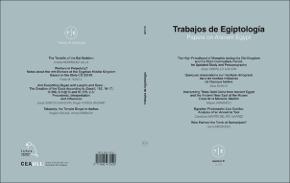Interpreting Three Gold Coins from Ancient Egypt and the Ancient Near East at the Museo Casa de la Moneda, Madrid
Author
Jaramago, MiguelDate
2018Abstract
The aim of this paper is to study three gold coins from the pre-Hellenistic Egypt and Near East, housed in the Museum Casa de la Moneda, Madrid, since 1955. In all three cases, their description is made as well as a review of the hypotheses that have been issued on their typology. Some novel proposals are made about their iconography and the possible gold sources for the raw material.
The first is a Daric, probably coined between the beginning of the reign of Xerxes I and the fall of Sardis under Alexander the Great. The study provides an original indication about its iconography, as well as about the possible (and vague) relationship of Persian imperial coinage with Zoroastrianism, the official religion of the Achaemenid Dynasty.
The nbw nfr coin is an Egyptian coinage from the Nectanebos Dynasty; one of the few hundred preserved copies. The iconography of the horse on the obverse is explored from the art and plastic of pre- and post-Sebenitic Egypt, and some technical aspects of the elaboration of the coin from the type of its reverse are analysed. From an epigraphic point of view, a new reading of the nbw nfr group is proposed.
The Double Daric is a complex currency, both regarding the precise determination of its chronology, as well as its interpretation and recipients. It is a coinage made possibly in Babylon with a broad chronology from 331 BCE until ca. 306 BCE. En el presente trabajo se estudian tres monedas de oro del Próximo Oriente pre-helenístico, que se encuentran en el Museo Casa de la Moneda, Madrid, desde el año 1955. En los tres casos se realiza una descripción y una revisión de las hipótesis que se han emitido sobre sus tipos. También se hacen algunas propuestas sobre su iconografía y las posibles fuentes auríferas de la materia prima.
La primera es un dárico acuñado probablemente entre los comienzos del reinado de Jerjes I y la caída de Sardes bajo Alejandro Magno. El estudio aporta una indicación original en torno a su iconografía, así como sobre la posible (y vaga) relación de las acuñaciones imperiales persas con el zoroastrismo.
La moneda nbw nfr es una acuñación egipcia de la dinastía de los Nectanebos; una del escaso centenar de ejemplares conservados. Se explora la iconografía del caballo del anverso a partir del arte y la plástica del Egipto pre y postsebenítico, y se analizan algunos aspectos técnicos de la elaboración de la moneda a partir del tipo de su reverso. Desde un punto de vista epigráfico, se propone una nueva lectura del grupo nbw nfr.
Por último, se presenta un doble dárico. Se trata de una moneda compleja, tanto en lo tocante a la determinación precisa de su cronología, como a su interpretación, destinatarios, etc. Se revisa su posible acuñación en Babilonia y se le asigna una cronología amplia, desde el 331 a.e. hasta ca. 306 a.e.





